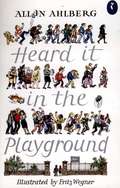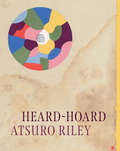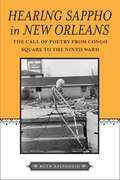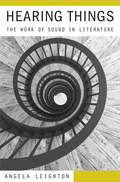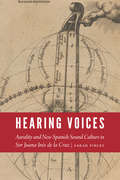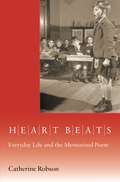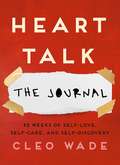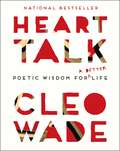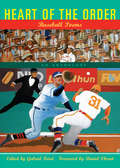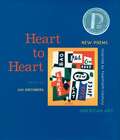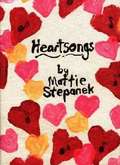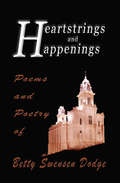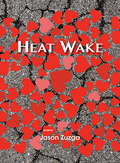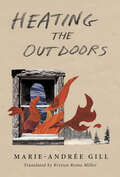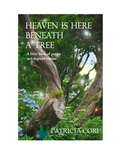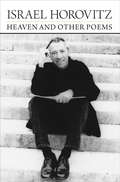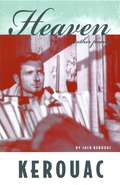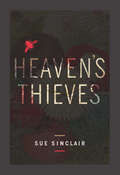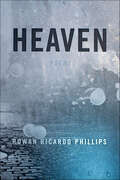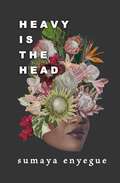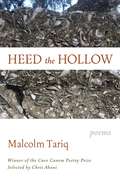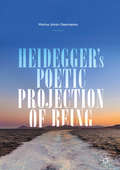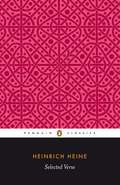- Table View
- List View
Heard it in the Playground
by Allan Ahlberg'The teacher tapped his forehead. At last! the children cried!The answer, Sir's, in your head...What a perfect place to hide'Jump into Allan Ahlberg's playful world of poetry, perfect for primary school children.Shed a tear for The Boy Without A Name, discover the secrets to teachers (they NEVER leave the school!?) and try to solve the riddles of The Answer. Packed with rhythmic poetry and playful songs, this timeless collection has delighted children for generations.'Every desk should hide a copy; every staff room own one' - The ObserverDiscover more school stories from Alan Ahlberg:Starting SchoolPlease Mrs Butler
Heard-Hoard
by Atsuro RileyWinner of the Alice Fay di Castagnola Award from the Poetry Society of America, this new collection of verse from Atsuro Riley offers a vivid weavework rendering and remembering an American place and its people. Recognized for his “wildly original” poetry and his “uncanny and unparalleled ability to blend lyric and narrative,” Atsuro Riley deepens here his uncommon mastery and tang. In Heard-Hoard, Riley has “razor-exacted” and “raw-wired” an absorbing new sequence of poems, a vivid weavework rendering an American place and its people. At once an album of tales, a portrait gallery, and a soundscape; an “inscritched” dirt-mural and hymnbook, Heard-Hoard encompasses a chorus of voices shot through with (mostly human) histories and mysteries, their “old appetites as chronic as tides.” From the crackling story-man calling us together in the primal circle to Tammy figuring “time and time that yonder oak,” this collection is a profound evocation of lives and loss and lore.
Heard-Hoard
by Atsuro RileyWinner of the Alice Fay di Castagnola Award from the Poetry Society of America, this new collection of verse from Atsuro Riley offers a vivid weavework rendering and remembering an American place and its people. Recognized for his “wildly original” poetry and his “uncanny and unparalleled ability to blend lyric and narrative,” Atsuro Riley deepens here his uncommon mastery and tang. In Heard-Hoard, Riley has “razor-exacted” and “raw-wired” an absorbing new sequence of poems, a vivid weavework rendering an American place and its people. At once an album of tales, a portrait gallery, and a soundscape; an “inscritched” dirt-mural and hymnbook, Heard-Hoard encompasses a chorus of voices shot through with (mostly human) histories and mysteries, their “old appetites as chronic as tides.” From the crackling story-man calling us together in the primal circle to Tammy figuring “time and time that yonder oak,” this collection is a profound evocation of lives and loss and lore.
Hearing Sappho in New Orleans: The Call of Poetry from Congo Square to the Ninth Ward (Southern Literary Studies)
by Ruth SalvaggioWhile sifting through trash in her flooded New Orleans home, Ruth Salvaggio discovered an old volume of Sappho's poetry stained with muck and mold. In her efforts to restore the book, Salvaggio realized that the process reflected how Sappho's own words were unearthed from the refuse of the ancient world. Undertaking such a task in New Orleans, she sets out to recover the city's rich poetic heritage while searching through its flooded debris. Hearing Sappho in New Orleans is at once a meditation on this poetic city, its many languages and cultures, and a history of its forgotten poetry. Using Sappho's fragments as a guide, Salvaggio roams the streets and neighborhoods of the city as she explores the migrations of lyric poetry from ancient Greece through the African slave trade to indigenous America and ultimately to New Orleans.The book also directs us to the lyric call of poetry, the voice always in search of a listener. Writing in a post-Katrina landscape, Salvaggio recovers and ponders the social consequences of the "long song" -- lyric chants, especially the voices of women lost in time -- as it resonates from New Orleans's "poetic sites" like Congo Square, where Africans and Indians gathered in the early eighteenth century, to the modern-day Maple Leaf Bar, where poets still convene on Sunday afternoons. She recovers, for example, an all-but-forgotten young Creole woman named Lélé and leads us all the way up to celebrated contemporary writers such as former Louisiana poet laureate Brenda Marie Osbey, Sybil Kein, Nicole Cooley, and Katherine Soniat.Hearing Sappho in New Orleans is a reminder of poetry's ability to restore and secure fragile and fragmented connections in a vulnerable and imperiled world.
Hearing Things: The Work of Sound in Literature
by Angela LeightonHearing Things is a meditation on sound’s work in literature. Drawing on critical works and the commentaries of many poets and novelists who have paid close attention to the role of the ear in writing and reading, Angela Leighton offers a reconsideration of literature itself as an exercise in hearing. An established critic and poet, Leighton explains how we listen to the printed word, while showing how writers use the expressivity of sound on the silent page. Although her focus is largely on poets—Alfred Tennyson, W. B. Yeats, Robert Frost, Walter de la Mare, Wallace Stevens, Elizabeth Bishop, Jorie Graham, and Alice Oswald—Leighton’s scope includes novels, letters, and philosophical writings as well. Her argument is grounded in the specificity of the text under discussion, but one important message emerges from the whole: literature by its very nature commands listening, and listening is a form of understanding that has often been overlooked. Hearing Things offers a renewed call for the kind of criticism that, avoiding the programmatic or purely ideological, remains alert to the work of sound in every literary text.
Hearing Voices: Aurality and New Spanish Sound Culture in Sor Juana Inés de la Cruz (New Hispanisms)
by Sarah FinleyHearing Voices takes a fresh look at sound in the poetry and prose of colonial Latin American poet and nun Sor Juana Inés de la Cruz (1648/51–95). A voracious autodidact, Sor Juana engaged with early modern music culture in a way that resonates deeply in her writing. Despite the privileging of harmony within Sor Juana’s work, however, links between the poet’s musical inheritance and subjects such as acoustics, cognition, writing, and visual art have remained unexplored. These lacunae have marginalized nonmusical aurality and contributed to the persistence of both ocularcentrism and a corresponding visual dominance in scholarship on Sor Juana—and indeed in early modern cultural production in general. As in many areas of her work, Sor Juana’s engagement with acoustical themes restructures gendered discourses and transposes them to a feminine key. Hearing Voices focuses on these aural conceits in highlighting the importance of sound and—in most cases—its relationship with gender in Sor Juana’s work and early modern culture. Sarah Finley explores attitudes toward women’s voices and music making; intersections of music, rhetoric, and painting; aurality in Baroque visual art; sound and ritual; and the connections between optics and acoustics. Finley demonstrates how Sor Juana’s striking aurality challenges ocularcentric interpretations and problematizes paradigms that pin vision to logos, writing, and other empirical models that traditionally favor men’s voices. Sound becomes a vehicle for women’s agency and responds to anxiety about the female voice, particularly in early modern convent culture.
Heart Beats: Everyday Life and the Memorized Poem
by Catherine RobsonMany people in Great Britain and the United States can recall elderly relatives who remembered long stretches of verse learned at school decades earlier, yet most of us were never required to recite in class. Heart Beats is the first book to examine how poetry recitation came to assume a central place in past curricular programs, and to investigate when and why the once-mandatory exercise declined. Telling the story of a lost pedagogical practice and its wide-ranging effects on two sides of the Atlantic, Catherine Robson explores how recitation altered the ordinary people who committed poems to heart, and changed the worlds in which they lived. Heart Beats begins by investigating recitation's progress within British and American public educational systems over the course of the nineteenth and twentieth centuries, and weighs the factors that influenced which poems were most frequently assigned. Robson then scrutinizes the recitational fortunes of three short works that were once classroom classics: Felicia Hemans's "Casabianca," Thomas Gray's "Elegy Written in a Country Churchyard," and Charles Wolfe's "Burial of Sir John Moore after Corunna." To conclude, the book considers W. E. Henley's "Invictus" and Rudyard Kipling's "If--," asking why the idea of the memorized poem arouses such different responses in the United States and Great Britain today. Focusing on vital connections between poems, individuals, and their communities, Heart Beats is an important study of the history and power of memorized poetry.
Heart Talk: 52 Weeks of Self-Love, Self-Care, and Self-Discovery
by Cleo WadeBased on Cleo Wade&’s bestselling book, Heart Talk, these pages string together gentle prompts, words of encouragement, and inquiries into the body, mind, and soul.Inspired by her conversations with the thousands of fans she has met on her nationwide sold-out tours, Heart Talk: The Journal is a space to share your own truths alongside hers. As Cleo writes, &“The best thing about your life is that it is constantly in a state of design. This means you have, at all times, the power to redesign it. Make moves, allow shifts, smile more, do more, do less, say no, say yes—just remember, when it comes to your life, you are not only the artist but the masterpiece, as well.&” Inside, you will find the opportunity to let go, feel what you need to feel, discover your own poetic wisdom, and become the person you want to be.
Heart Talk: Poetic Wisdom for a Better Life
by Cleo WadeA beautifully illustrated book from Cleo Wade—the artist, poet, and speaker who has been called &“the Millennial Oprah&” by New York Magazine—that offers creative inspiration and life lessons through poetry, mantras, and affirmations, perfect for fans of the bestseller Milk & Honey.True to her hugely popular Instagram account, Cleo Wade brings her moving life lessons to Heart Talk, an inspiring, accessible, and spiritual book of wisdom for the new generation. Featuring over one hundred and twenty of Cleo&’s original poems, mantras, and affirmations, including fan favorites and never before seen ones, this book is a daily pep talk to keep you feeling empowered and motivated. With relatable, practical, and digestible advice, including &“Hearts break. That&’s how the magic gets in,&” and &“Baby, you are the strongest flower that ever grew, remember that when the weather changes,&” this is a portable, replenishing pause for your daily life. Keep Heart Talk by your bedside table or in your bag for an empowering boost of spiritual adrenaline that can help you discover and unlock what is blocking you from thriving emotionally and spiritually.
Heart of the Order: Baseball Poems
by Gabriel FriedNearly 100 poems about that most literary of sports: baseball. An anthology of classic and contemporary poems by some of America's top authors--in a beautifully designed, portable edition that will be treasured by all baseball fans. Here is an impressive roster of poets from the past 75 years, including Hall of Famers like Richard Hugo, Irving Feldman, William Matthews, Marianne Moore, Ogden Nash, and May Swenson, and contemporary All-Stars like B.H. Fairchild, Linda Gregerson, Donald Hall, Denis Johnson, Yusef Komunyakaa, Thomas Lux, Gail Mazur, and others. In all, nearly one hundred poets represent the spectrum of verse writing about the National Pastime: from stickball and sandlot games to the Majors, from spectators to scrubs and superstars. They underscore baseball's particular poetic sensibility, capturing its rhythms, culture, and timelessness. Includes a Foreword by Daniel Okrent, acclaimed author (Nine Innings, Last Call, and others), inaugural Public Editor of the New York Times, and inventor of Rotisserie League Baseball, also known as Fantasy Baseball. A very classy collection, excellent poetry and excellent baseball--a perfect gift.
Heart to Heart New Poems Inspired by Twentieth-Century American Art
by Jan GreenbergWhat do we feel when we look at a great work of art<P><P> What does a poet feel<P> Heart to Heart offers an original way to approach poetry and art—with new works by distinguished American poets, specially commissioned for this book by editor Jan Greenberg. Prompted by paintings, sculpture, prints, and photographs by American artists working in the 20th century, these poems lend a new meaning to “art appreciation” and make each page of Heart to Heart an exciting discovery.<P> Join such poets as Jane Yolen, Nancy Willard, X. J. Kennedy, Naomi Shihab Nye, David Mura, and Angela Johnson as they reveal a personal, heartfelt response to works by Thomas Hart Benton, Romare Bearden, Jacob Lawrence, Grandma Moses, Faith Ringgold, Man Ray, Georgia O’Keeffe, and many others. Whether the poems are playful, challenging, tender, mocking, humorous, sad, or sensual, each work of art, seen through the eyes of a poet, allows readers to look at the world with new insight.
Heartsongs
by Mattie StepanekMatthew Joseph Thaddeus Stepanek, known to his friends as "Mattie," began writing poetry and short stories at the age of three. Some of his works explore the uncensored reality of living with a rare form of muscular dystrophy and with the grief associated with the loss of his three siblings to the same Iife-threattning condition. But most of his work proclaims the innocent hope, profound wisdom and delightful humor of childhood Other books by this author are available from Bookshare..
Heartstrings and Happenings: Poems and Poetry of Betty Swensen Dodge
by Betty DodgeElizabeth Holroyd Shipley Swensen Dodge (Betty) was born, ninth of eleven children, in Sutherland, Utah on January 8, 1917. The mother of five children, her life as an active member of the Church of Jesus Christ of Latter-day Saints included a full time mission and nearly two decades as an ordinance worker in the Jordan River Temple. She has been a widow for nearly 50 years. Her poems of insights and compassion reflect the heartstrings and happenings of a mother, widow, friend, and a women committed to the the teachings of Jesus Christ.
Heat Wake
by Jason ZuzgaMixing science with humor, humanity, whimsy and love, Jason Zuzga's debut collection is a revelation. In Heat Wake, the reader encounter natures in myriad forms, all crafted from the unusual perspective of a poet astonished by the world and at work among the queerness of life, the odd sweetness of other people, the city, nature, love, and humanity. The poems unfold amid the presence of stubborn rocks, the vast ocean and its shores, the intimate details of a suburban New Jersey landscape. The book's exuberant poems take a journey through time itself: the limited time of humans versus time evolutionary and geological. The poems present in rollicking, playful language and joyful imagery, glancing at the infinite and at the future imagined from the desert in Arizona to Mars. "Charming, witty, and science-y smart, these debut collection poems pop with volleys of youthful and wise acts, tactics, maneuvers, catastrophes, scenes, and did I mention love poems overrunning! --Jane Miller
Heating the Outdoors
by Marie-Andrée Gill Kristen Renee MillerYou're the clump of blackened sprucethat lights my gasoline-soaked heartIt's just impossible you won't be backto quench yourself in my crème-sodaancestral spiritIrreverent and transcendent, lyrical and slang, Heating the Outdoors is an endlessly surprising new work from award-winning poet Marie-Andrée Gill.In these micropoems, writing and love are acts of decolonial resilience. Rooted in Nitassinan, the territory and ancestral home of the Ilnu Nation, they echo the Ilnu oral tradition in Gill's interrogation and reclamation of the language, land, and interpersonal intimacies distorted by imperialism. They navigate her interior landscape—of heartbreak, humor, and, ultimately, unrelenting light—amidst the boreal geography.Heating the Outdoors describes the yearnings for love, the domestic monotony of post-breakup malaise, and the awkward meeting of exes. As the lines between interior and exterior begin to blur, Gill's poems, here translated by Kristen Renee Miller, become a record of the daily rituals and ancient landscapes that inform her identity not only as a lover, then ex, but also as an Ilnu and Québécoise woman.
Heaven Is Here, Beneath a Tree
by Patricia CoriThis little book of profound images and poems from best-selling author/photographer Patricia Cori reflects her inspiration and vision of life and our world. It is intended as a point of reference for the reader, to see over and over again, and to draw strength, joy, and empowerment from the messages that pour from Cori's provocative art and words--messages that truly speak from the soul.Little Books by Patricia Cori is series of concise, digital-only treatises that express the author's wisdom and insights into the meaning of creation. They are connected by a common thread: the author's love for the earth and the most distant stars; her passion for life; and her dedication to spirit.
Heaven and Other Poems
by Israel HorovitzWith more than 70 produced plays and many produced screenplays, playwright/director/author Israel Horovitz presents a new dimension to his creative output in Heaven and Other Poems, the 75-year-old author's first-ever authorized poetry collection. A tour-de-force of emotion, empathy and deep, melancholic beauty, Heaven and Other Poems is a stunning collection of work crafted over a lifetime. From the epic poem "Stations of the Cross" with its startling, tenderly crafted images of familial love and loss, to the punchy and pointed aphorisms of the twin "Defining the French Novel" and "Defining the American Novel" Horovitz displays a remarkable range, and#151;throughout#151;a deep understanding of humanity. As the most-produced American playwright in French theatre history, many of his poems naturally are set in France, where Horovitz often directs French-language productions of his plays. The collection is filled with surprises and special gifts, such as the never-before-published translation of one of his poems by master playwright Samuel Beckett, from whom Horovitz found thematic and stylistic inspiration for his own work. A truly inspired poetry collection, which is, in turn, truly inspiring and fulfilling to its audience.
Heaven and Other Poems
by Jack KerouacHeaven and a choice of poems sent to editor Donald Allen for anthology and magazine publication. With a selection of Jack's letters on his poetry and a biographical note.
Heaven's Thieves
by Sue SinclairHeaven's Thieves is a collection engaged with the big questions -- What are bodies for? What does it mean to be alive? What is beauty and why does it have such power over us? What is the point of art? -- and the urgent ones -- how to live in a shattered ecology, what to do about grief, illness, betrayal. Sinclair turns her attention to these questions with fearless curiosity, economy, and an originality born of her willingness to pursue her own line of inquiry to its limit. These poems get close and cut deep, mixing subject and object, surface and soul: "Red mud glistens / like cut fruit -- or like the knife / that did the cutting, laid down." In this, her fifth collection, Sinclair knows that nature is both "done to death" and "inexhaustible;" that art is an elegy for experience. Experience and its value are changed in these poems. They are as wise as they are disruptive, and they change us as surely as they remake the world.
Heaven: Poems
by Rowan Ricardo PhillipsOne of The Washington Post's Best Poetry Collections of 2015One of NPR's Best Books of 2015Long-listed for the National Book Award in poetry"Who the hell's heaven is this?" Rowan Ricardo Phillips offers many answers, and none at all, in Heaven, the piercing and revelatory encore to his award-winning debut, The Ground. Swerving elegantly from humor to heartbreak, from Colorado to Florida, from Dante's Paradise to Homer's Iliad, from knowledge to ignorance to awe, Phillips turns his gaze upward and outward, probing and upending notions of the beyond. "Feeling, real feeling / with all its faulty / Architecture, is / Beyond a god's touch"—but it does not elude Phillips. Meditating on feverish boyhood, on two paintings by Chuck Close, on Shakespeare's Measure for Measure, on a dead rooster by the side of the road in Ohio, on an elk grazing outside his window, his language remains eternally intoxicating, full of play, pathos, and surprise. "The end," he writes, "like / All I've ever told you, is uncertain." Or, elsewhere: "The only way then to know a truth / Is to squint in its direction and poke." Phillips—who received a 2013 Whiting Writers' Award as well as the PEN/Joyce Osterweil Award—may not be certain, but as he squints and pokes in the direction of truth, his power of perception and elegance of expression create a place where beauty and truth come together and drift apart like a planet orbiting its star. The result is a book whose lush and wounding beauty will leave its mark on readers long after they've turned the last page.
Heavy is the Head
by Sumaya Enyegue&“Where does all the grief go when it&’s not tugging at your wrist?&” Enyegue&’s debut collection is an ode to girlhood, to Blackness, to generational trauma, sexual assault, and mental health.This collection does not aim to heal anyone who reads it, but instead help them confront their own healing. Rather than sugar-coated bullets that enter you lightly, these poems are designed to hurt. They are for the girls with difficult names, the boys with softness at their core, and the people with neither. They are meant for the people who are Black, and the people who are not—because we are all tethered together by the heaviness of the human experience.
Heed the Hollow: Poems
by Malcolm TariqThe stirring debut from the winner of the Cave Canem Poetry Prize, selected and introduced by Chris AbaniHeed the Hollow introduces the work of Malcolm Tariq, whose poems explore the concept of “the bottom” across blackness, sexuality, and the American South. These lyrics of queer desire meet the voices of enslaved ancestors to reckon with a lineage of trauma that manifests as silence, pain, and haunting memories, but also as want and love. In bops, lyrics, and erasures, Heed the Hollow tells of a heritage anchored to the landscape of the coastal South, to seawalls shaped by forced labor, and to the people “marked into the bottom / of history where then now / we find no shadow of life.” From that shadow, the voices in these poems make their own brightness, reclaiming their histories from a language that evolved to exclude them.
Heidegger's Poetic Projection of Being
by Marius Johan GeertsemaThis book investigates the relationship between poetry and ontology in the works of Martin Heidegger. It explains the way in which Heidegger’s dialogue with poetry forms an essential step on the path of overcoming metaphysics and thinking the openness of presence. Heidegger’s engagement with poetry is an important moment in the development of his philosophy—or rather thinking of Being. Being speaks itself poetically in his view. Rather than a logician or a thinker, Being is the first poet.
Heine: Selected Verse
by Heinrich Heine Peter Branscombe'One of the first men of this century' is how Heine described himself when he claimed to have been born in the early hours of 1800. It was typical of Heine to create this humorous doubt - he was in fact born in 1797. He was a restless and homeless poet, a Jew among Germans, a German in Paris, a rebel among the bourgeoisie and always, as his famous doppelgänger poems show, a man divided against himself. This selection, with the German originals accompanied by English prose translations, provides the perfect introduction to Heine. He can be magnificent as an acute, irreverent commentator on politics and current events, though his genius most often strikes home in the poems filled with despair, or sensuality, or sweetness, or self-mockery, in which he draws out the whole gamut of emotions provoked by love and immanent death.
